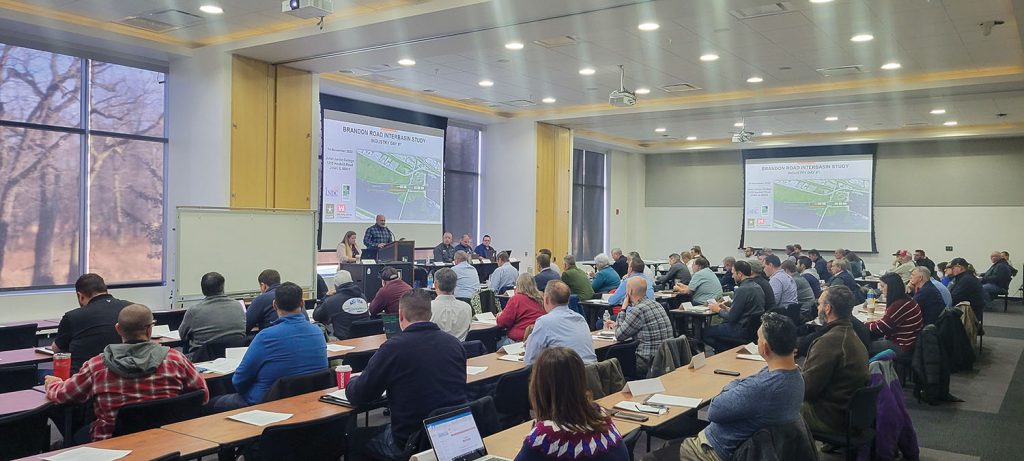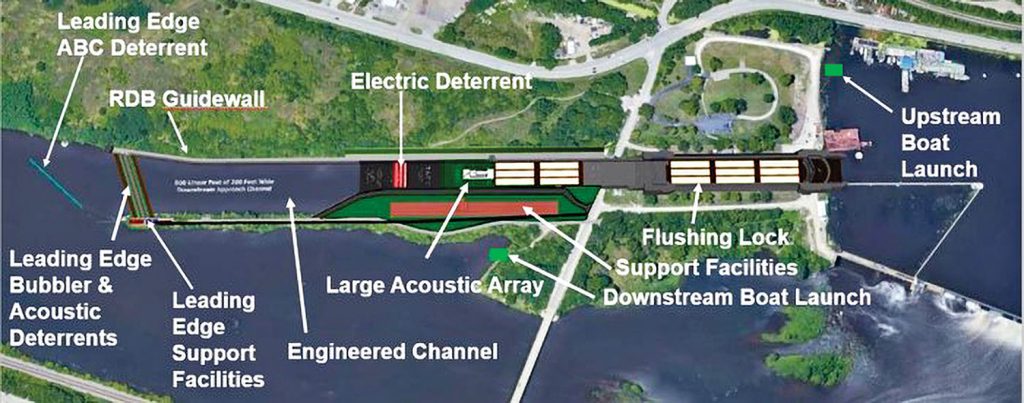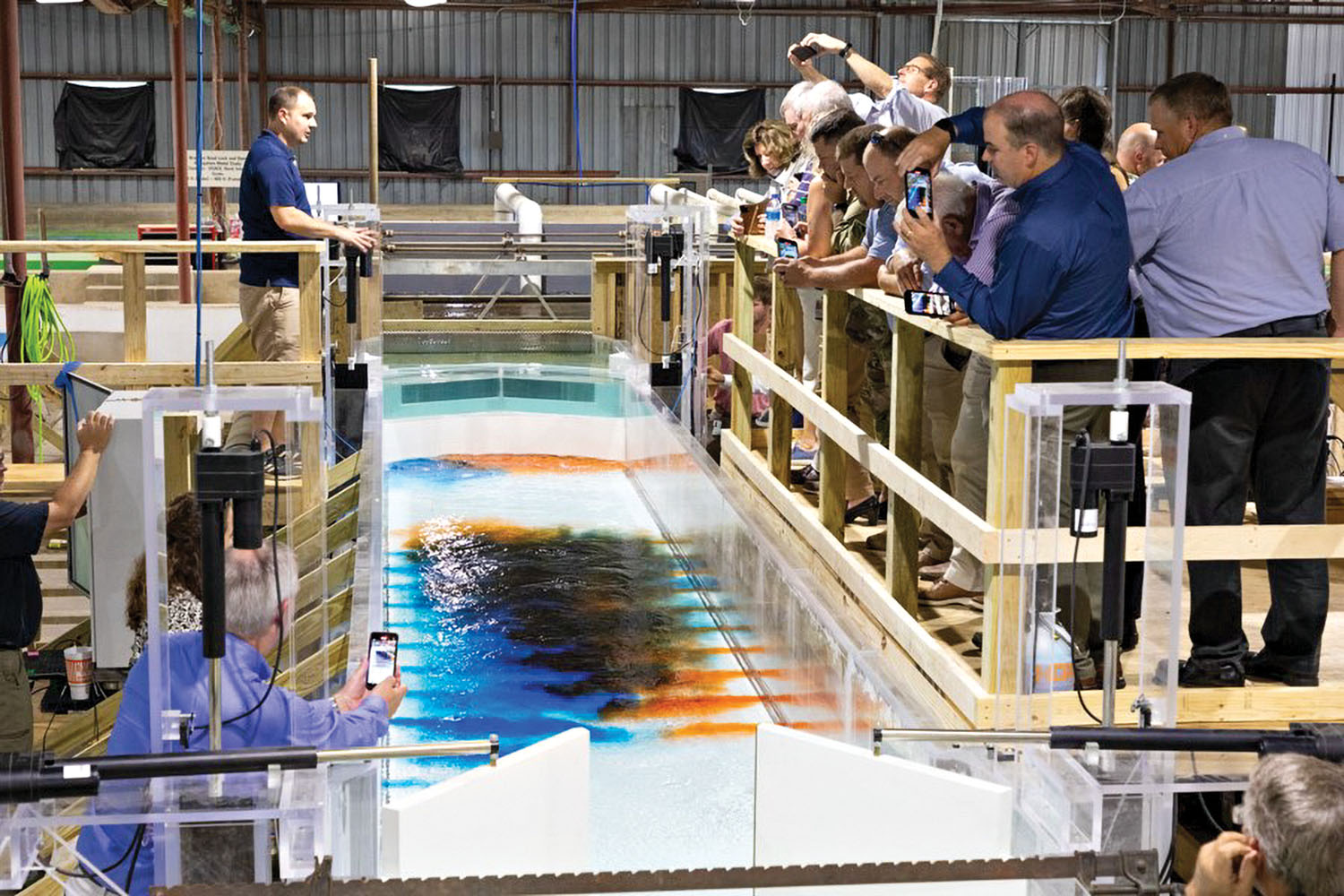Still without a project partnership agreement, funding for the Brandon Road Interbasin Project is in danger of lapsing.
The project, on the Des Plaines River near Joliet, Ill., includes a complex, layered barrier to prevent the spread of invasive carp and other nuisance aquatic species from the river into the Great Lakes. It consists of an engineered channel with a flushing lock, an air bubble curtain and an acoustic deterrent, all designed to work in tandem with an electric barrier in place in the Chicago Sanitary and Ship Canal in Romeoville, Ill., southwest of Chicago. Brandon Road Lock and Dam has been identified previously as a key choke-point where Asian carp must be stopped.

Design funding for the project was expected to run out at the end of January without an agreement in place to access more. Stakeholders were meeting at WJ press time, trying to reach an agreement that would allow $5.5 million from the non-federal sponsor, currently deposited in an escrow fund, to be advanced to keep the project on track.
Project Funding Match Decreased
Preconstruction engineering, design and construction of the initial phase of the project received $226 million from the Infrastructure Investment and Jobs Act and $47 million in the president’s budget for fiscal year 2023, but the project requires a 10 percent match from the non-federal sponsor, only a portion of which has been allocated.
While funding is also coming from the state of Michigan, the state of Illinois is the signatory to the agreement with the Corps of Engineers.
Originally, the project required a 20 percent match, but the percentage was halved to 10 percent in a provision of the 2022 Water Resources Development Act (WRDA) passed by Congress. The Council of Great Lakes Governors had previously sent a letter to congressional infrastructure leadership seeking full federal funding for the project and saying non-federal sponsor funding was “beyond the capacity of the Great Lakes states to match.”
Design Altered, Cost Examined
The project was originally estimated to cost roughly $1 billion, but the Corps of Engineers has made multiple changes to the original design in an attempt to retain its objectives while lessening the cost. That included reducing the engineered channel’s width from 225 feet to 110 feet at the electric carp barrier, shortening the height and length of guidewalls and concreting only 1,200 feet of the 2,000-foot channel’s floor, among other measures, said Andrew Leichty, who oversees the project as senior project manager for the Rock Island Engineer District.
A new analysis of the total project cost, expected to reflect any increased labor and materials costs due to inflation, is due in the next 30 to 45 days, Leichty said. The state of Illinois is awaiting the results of that determination while also continuing to review the language of the agreement, Leichty said.

Scott Whitney, chief of the project management branch for the Rock Island District, noted that the navigation industry has been key in helping the Corps to determine what aspects of the project could be reduced without increasing the time for a tow to lock through by more than 15 minutes.
Several towboat captains have given input into modeling at the U.S. Army Engineer Research and Development Center (ERDC) in Vicksburg, Miss., Whitney said.
“They’ve been instrumental in the design process,” he said.
He noted that among the considerations are unique entrance and exit conditions for the engineered channel as well as issues with cross-currents.
Additionally, Whitney said, about 100 contractors and other representatives from the construction and navigation industries toured the lock and dam during an Industry Day last fall designed to give more feedback on the project.
“Our interest is in making this happen seamlessly and with the least disruption to the navigation industry as possible,” Whitney said.
Even if funded, those impacts will not be immediate. The project schedule calls for awarding the first construction contract in 2024, with some limited restrictions on tow sizes necessary no sooner than spring 2024, Whitney said. A series of estimated 45-day closures, during which the lock would be dewatered, are not expected to begin before 2025, he said.
Prioritizing Remaining Funds
Design work on the project so far has concentrated on the first phase, designated as increment 1A. The design is complete to 65 percent for bubblers, acoustic deterrents and an automated barge clearing deterrent designed to free invasive carp trapped between the rake and box ends of abutting barges in a tow.
“What we wanted to do is keep moving on to get to a 95 percent design, but we’re ramping down,” Leichty said.
While some fiscal year 2022 funds were available to carry over into 2023, those were expected to run out by the end of January, he said.
“We’re focused on priority activities that we need to carry forward and making sure we have projects as complete as possible before having a clearly abrupt stop,” Leichty said.
‘Bridge’ Funding
Whitney said that with the project partnership agreement unlikely to be signed before funding runs out, the Corps is now working with Illinois in an attempt to access state funding already available in an escrow fund through an accelerated funds agreement.
The accelerated funds agreement is an option within the overall agreement for the project, but executing it requires approval at the highest level of the Corps along with notification of congressional subcommittees and agreement from all the parties, including the non-federal sponsor.
“That creates a bridge until we get to a PPA,” Whitney said.
Final approval from the Office of Management and Budget and notification that the congressional subcommittees had been notified was received January 3 as part of the design agreement amendment, Whitney said. As of press time, attorneys for the Corps and the state of Illinois continued to review the final documents before committing to sign it.
Whitney said the Rock Island District is optimistic that the project will be able to move forward while also preparing for the possibility that it may not.
He said, “We have every hope that that’s going to be the case, but we’re poised to have to stand things down pretty quickly.”
Caption for top photo: Flushing lock model demonstrated at the Brandon Road Interbasin Study Industry Day in November. (Photo courtesy of the Rock Island Engineer District)



